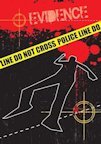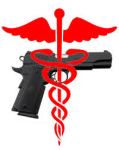What are the odds that someone who is discharged from a hospital after treatment for a gunshot injury will return to the hospital with another serious injury or will be arrested for committing a serious crime? For the first time a study attempts to answer that question based on enough data to discuss how the medical community should respond to people who seek medical help after being assaulted with a gun. The Annals of Internal Medicine contains a study of more than 9,000 patients who were admitted to hospitals in Washington State with violent injuries in 2006-2007 and were then followed through December, 2011 or to their next subsequent hospitalization, arrest, or death, or whichever came first. The findings about this group were then compared to 68,000 patients who were discharged during the same two-year period but had been treated for non-violent injury, along with a comparison to 180,000 patients comprising the general population.
 Before we compare the long-term experiences of all three groups, let’s look at the composition of the violent injury group itself. Of all patients treated between 2006 and 2007 for violent injury, roughly 7.5% were admitted for injuries involving guns, or what the researchers refer to as firearm-related hospitalizations or FRH. But the FRH number was actually 21% of all assaults, since 65% of all serious injuries were self-inflicted (accidents and the like.) The ratio of one out of five assaults in which a gun was used is no different from what the FBI reports across the nation as a whole.
Before we compare the long-term experiences of all three groups, let’s look at the composition of the violent injury group itself. Of all patients treated between 2006 and 2007 for violent injury, roughly 7.5% were admitted for injuries involving guns, or what the researchers refer to as firearm-related hospitalizations or FRH. But the FRH number was actually 21% of all assaults, since 65% of all serious injuries were self-inflicted (accidents and the like.) The ratio of one out of five assaults in which a gun was used is no different from what the FBI reports across the nation as a whole.
Patients admitted in 2006-2007 for gun injuries were also typical of this population in general, with nearly 75% being less than 40 years old, and 85% being male. Racial data was not available for this study, but interestingly, one-third of all victims of gun violence in Washington State paid their hospital bills with private insurance, whereas the Urban Institute recently calculated that less than 5% of all hospital admissions for gun-related violence were covered by private plans.
Here’s the bottom line. A patient who was treated and discharged for a gun injury in 2006 and 2007 had a significantly higher chance of then being killed with a gun or being arrested for some kind of violent assault. A history of criminality prior to the hospitalization increased the likelihood of post-discharge victimization or criminal behavior even further. The point is that a medical encounter for the treatment of gun violence does not just represent a challenge to respond to the injuries caused by the specific gun-related event. It is also a harbinger of further medical challenges to come and should be understood and responded to in the context of an ongoing and continuous medical risk.
Other studies have also shown that violent injury is a recurring disease. Earlier this year JAMA Pediatrics published an article which showed a clear division between two youthful populations, ages 14-24, who were treated by Emergency Departments in Flint, MI. The groups were divided between those patients whose first visit to the ER was for violent injury, the other group came to the ER for something else. What then happened was that a significant number of the patients who first sought medical care for injury returned to seek care for the same problem again. Not a single member of the latter population that came to the ER for something other than violent injury ever sought medical care for any kind of serious assault.
The Annals issue containing the study on violent recidivism also held an editorial in which eight of the major medical associations (ACP, AECP, AAP, ACS, etc.,) called for stronger physician commitment and endorsed a list of public health initiatives to deal with the medical risks of guns. But I think that physicians need to do more than just support public health strategies in this regard. What they really should do is develop effective medical strategies based on research like the articles cited above. After all, it’s ultimately what the doctor tells the patient which makes any difference at all.





Recent Comments